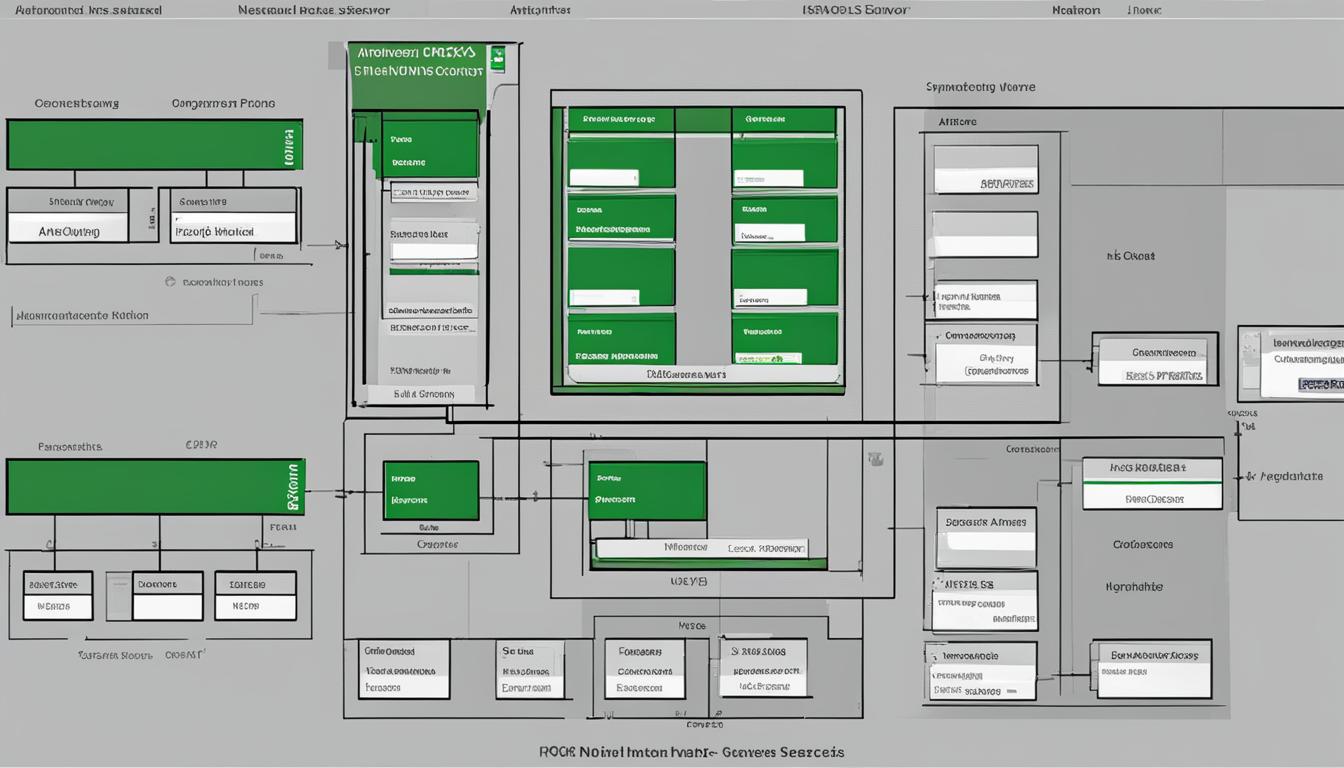Understanding nginx Server Blocks Explained
As an IT professional with expertise in web servers, I want to provide you with a comprehensive understanding of nginx server blocks. Whether you are a developer, administrator, or simply curious about server configurations, this article will equip you with the knowledge to navigate nginx server blocks with confidence.
Nginx, a widely-used web server, offers powerful capabilities, serving as a web server, mail server, or reverse proxy server. Server blocks, an essential feature of nginx, allow you to define virtual servers to handle requests for specific domains, ports, and IP addresses. Think of server blocks as subsets of nginx’s configuration, enabling you to customize how nginx handles different types of requests. Let’s dive into the syntax, directives, and examples to demystify nginx server blocks.
Key Takeaways:
- nginx server blocks are used to define virtual servers within nginx’s configuration.
- Server blocks handle requests for specific domains, ports, and IP addresses.
- The listen directive specifies the IP address and port that a server block responds to.
- The server_name directive matches the value of the Host header in client requests.
- Location blocks further refine request handling by defining how the server responds to specific resources and URIs.
The listen directive in server blocks
The listen directive in Nginx is a crucial component of server block configuration. It allows you to specify the IP address and port that a server block will respond to, enabling effective communication between the server and clients.
When defining a server block, including the listen directive is essential to ensure proper functioning. If a server block does not include a listen directive, Nginx assigns default values of 0.0.0.0:80 for root users and 0.0.0.0:8080 for non-root users.
| Directive | Default Value |
|---|---|
| listen | 0.0.0.0:80 or 0.0.0.0:8080 |
To ensure clarity and prevent ambiguity, incomplete listen directives are automatically translated by Nginx. It substitutes any missing values with their corresponding default values, ensuring seamless communication between the server and clients.
The specificity of listen directives plays a significant role in server block selection. Nginx evaluates the IP address and port to determine the specificity of a listen directive. If multiple server blocks possess the same level of specificity, Nginx resorts to evaluating the server_name directive for further differentiation.
Example:
The listen directive in the server block below specifies that Nginx should respond to requests sent to 192.168.0.1:8080:
server { listen 192.168.0.1:8080; ... }
As seen in the image above, the listen directive combines the IP address and port to establish a connection between the server block and clients. This connection is crucial for effectively handling requests and ensuring the smooth functioning of the web server.
The server_name directive in server blocks
The server_name directive in Nginx is a crucial configuration option that allows administrators to match the value of the Host header in client requests. It plays a significant role in distinguishing between server blocks with the same level of specificity defined in the listen directive.
Nginx uses the server_name directive to determine which server block should handle incoming requests based on the value provided in the Host header. This directive supports various matching processes, including exact matches, wildcard matches, and regular expression matches, giving administrators flexibility in defining server block behavior.
When using the server_name directive, administrators can achieve an exact match by specifying the domain or IP address explicitly. An exact match configuration ensures that the specified server block handles requests only for that specific domain or IP address.
Wildcard matching allows for more dynamic server block selection, as it can match multiple subdomains or parts of a domain. For example, a wildcard match of “*.example.com” would match “test.example.com”, “subdomain.example.com”, and any other subdomain under the “example.com” domain.
In addition to exact and wildcard matches, Nginx supports regular expression matching with the server_name directive. Regular expressions provide advanced pattern matching capabilities, allowing administrators to define complex rules for server block selection based on the request’s Host header value.
If no server block with a matching server_name directive is found, Nginx selects the default server block for the corresponding IP address and port. The default server block typically contains generic configuration settings to handle requests that don’t match any other server blocks.
By utilizing the server_name directive in Nginx server blocks, administrators can precisely define the behavior of their virtual servers and ensure that requests are handled by the appropriate server block based on the Host header value provided by clients.
The role of location blocks
In Nginx, location blocks play a pivotal role in configuring how the server handles requests for specific resources and URIs within a server block. They provide a powerful mechanism for fine-tuning request handling based on various criteria.
Location blocks are defined within server blocks and can be nested to further refine request handling. When a request is received, Nginx evaluates location blocks in a specific order based on the URI space to determine the most appropriate block to handle the request.
Nginx matches requests to location blocks using the longest matching prefix. This allows administrators to specify different handling rules based on the specific URI being requested.
Location blocks can be used to configure a wide range of directives, including:
- File types: You can specify how Nginx should handle requests for different file extensions or MIME types.
- Access controls: Location blocks can be used to enforce access restrictions based on IP addresses, client headers, or other criteria.
- Proxying: Location blocks can be used to proxy requests to backend servers or other upstream services.
By leveraging the flexibility of location blocks, administrators can tailor the behavior of their Nginx server to meet the specific requirements of their applications and infrastructure.

Sample nginx location block configuration:
| Location | Directive | Value |
|---|---|---|
| /images/ | alias | /var/www/example.com/images/ |
| /api/ | proxy_pass | http://backend_server/ |
| /protected/ | deny | all; |
In the above example, the first location block defines an alias directive to serve image files from a specific directory. The second location block uses the proxy_pass directive to forward requests to a backend server. Lastly, the third location block denies access to a protected area of the website.
With the powerful configuration possibilities offered by location blocks, Nginx provides administrators with granular control over how requests are handled within their server blocks.
Conclusion
Understanding nginx server blocks is crucial for effectively managing and configuring the Nginx web server. Server blocks play a significant role in managing multiple domains and configurations on a single server. By utilizing server blocks, administrators have the ability to define virtual servers that handle requests for specific domains, ports, and IP addresses.
The main directives used for server selection within server blocks are the listen directive and server_name directive. The listen directive allows administrators to specify the IP address and port that a server block will respond to. In the absence of a listen directive, default values are assigned. The server_name directive is used to match the value of the Host header in client requests and is crucial in distinguishing between server blocks with the same level of specificity.
Location blocks further refine request handling within server blocks. They enable administrators to define how the Nginx server should handle requests for specific resources and URIs. Location blocks can be nested within server blocks and are evaluated based on the URI space. They are incredibly useful in configuring various directives for request handling, including file types, access controls, and proxying.
By gaining a solid understanding of the syntax and configuration of server blocks and location blocks, administrators can effectively manage and configure their Nginx web server. With the ability to handle high loads and function as a web server, mail server, or reverse proxy server, Nginx is a powerful tool for delivering exceptional performance and scalability.
FAQ
What is a server block in nginx?
A server block in nginx is a subset of the configuration used to define virtual servers that handle requests for specific domains, ports, and IP addresses.
Can you provide an example of a server block in nginx?
Sure! Here’s an example of a server block in nginx:
2
3
4
5
6
listen 80;
server_name example.com;
root /var/www/example;
index index.html;
}
How does the listen directive work in server blocks?
The listen directive is used to define the IP address and port that a server block will respond to. If a server block does not include a listen directive, it is given default values of 0.0.0.0:80 (or 0.0.0.0:8080 for non-root users). Nginx translates “incomplete” listen directives by substituting missing values with their default values. Nginx determines the specificity of listen directives by evaluating the IP address and port.
How does the server_name directive work in server blocks?
The server_name directive is used to match the value of the Host header in client requests. Nginx uses the server_name directive to distinguish between server blocks with the same level of specificity in the listen directive. The server_name directive can be used for exact matches, wildcard matches (leading or trailing), and regular expression matches. If no matching server block is found, Nginx selects the default server block for the IP address and port.
What is the role of location blocks in nginx server blocks?
Location blocks in nginx are used to define how the server should handle requests for specific resources and URIs within a server block. Location blocks can be nested within server blocks to further refine request handling. Nginx matches requests to location blocks based on the longest matching prefix. Location blocks can be used to configure various directives for request handling, such as file types, access controls, and proxying.
Source Links
- https://www.digitalocean.com/community/tutorials/understanding-nginx-server-and-location-block-selection-algorithms
- https://www.nginx.com/resources/wiki/start/topics/examples/server_blocks/
- https://www.educba.com/nginx-server-block/
- About the Author
- Latest Posts
Mark is a senior content editor at Text-Center.com and has more than 20 years of experience with linux and windows operating systems. He also writes for Biteno.com






